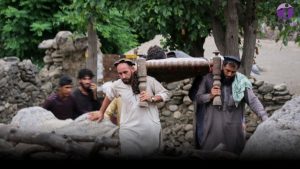Hurricane Melissa advanced into Cuba’s second-largest city as a formidable Category 4 hurricane on Tuesday, just after making landfall in Jamaica as the most potent cyclone ever recorded to impact that Caribbean nation.
Melissa made landfall near Jamaica’s southwestern town of New Hope, with sustained winds of up to 185 mph (295 kph), as reported by the US National Hurricane Centre, significantly exceeding the minimum wind speed of 157 mph (252 kph) required for a Category 5 storm, the highest classification on the Saffir-Simpson wind scale.
The parish of St. Elizabeth in southwestern Jamaica was reported to be “underwater,” according to an official, with over 500,000 persons lacking electricity.
Jamaica’s Prime Minister, Andrew Holness, stated on media post-storm that the reports received thus far indicate damage to hospitals, substantial destruction of residential and commercial properties, and impairment of road infrastructure.
Holness stated that the government has not yet confirmed any storm-related fatalities; nevertheless, due to the hurricane’s intensity and the magnitude of the destruction, “we anticipate that there may be some loss of life.”
The National Hurricane Centre said that Melissa’s winds diminished to 145 mph (233 kph) as the storm moved past the hilly island, impacting highland towns susceptible to landslides and flooding.
The hurricane was predicted to veer northeast, on a path towards Santiago de Cuba, Cuba’s second-most populous city.
Cuban President Miguel Diaz-Canel stated in a message published in the state daily Granma, “We should already be experiencing its primary impact this afternoon and evening,” urging inhabitants to comply with evacuation instructions.
Numerous tasks await completion. This cyclone is expected to inflict considerable damage.
Cuban authorities reported that over 500,000 people were instructed to relocate to higher ground. In the Bahamas, following Melissa’s trajectory to the northeast, the government mandated evacuations of residents in the southern regions of the archipelago.
Further east, the island jointly occupied by Haiti and the Dominican Republic has had several days of heavy rainfall, resulting in a minimum of four fatalities, according to local authorities.
Local media claimed a minimum of three fatalities in Jamaica during storm preparations, and a disaster coordinator experienced a stroke at the outset of the storm and was promptly transported to the hospital. As of late Tuesday, many areas remained isolated.
Jamaica’s ‘Tempest of the Century’
Jamaica, familiar with hurricanes, had never previously seen a direct impact from a Category 4 or 5 storm, prompting the government to request foreign assistance while preparing for Melissa’s impending arrival.
AccuWeather meteorologists reported that Melissa is the third-most-intense hurricane recorded in the Caribbean, behind Wilma in 2005 and Gilbert in 1988, the latter being the last significant storm to make landfall in Jamaica.
“It is a catastrophic situation,” stated Anne-Claire Fontan, a tropical cyclone specialist at the World Meteorological Organisation, at a press briefing, cautioning about storm surges reaching heights of up to 4 meters. “For Jamaica, it will undoubtedly be the storm of the century.”
Colin Bogle, an advisor to the assistance organisation Mercy Corps in Portmore, near Kingston, Jamaica’s capital, reported hearing a massive loud explosion in the morning before the onset of darkness. While seeking refuge with his grandma, he perceived incessant noise and observed trees violently swaying in the wind.
“Individuals are apprehensive.” Memories of Hurricane Gilbert are profound, and there is exasperation that Jamaica continues to endure the most severe repercussions of a climate problem we did not instigate,” he stated.
Researchers caution that storms are intensifying and becoming more frequent due to warming ocean waters. Numerous Caribbean politicians have urged affluent, high-emission nations to offer reparations through aid or debt alleviation to tropical island states.
Melissa’s dimensions and power intensified as it traversed the extremely warm Caribbean waters; however, meteorologists cautioned that its sluggish progression could be especially detrimental.
Bogle stated that food assistance, along with equipment, vehicle components, and seeds for agriculturalists, will be essential. Similar to last year’s catastrophic Hurricane Beryl, Melissa traversed several of Jamaica’s most fertile agricultural regions.
On Monday, Holness announced that the government had an emergency budget of $33 million, along with insurance and credit reserves for damage slightly exceeding that of Beryl.
‘LIKE A THUNDERING LION’
Melissa made landfall in southwestern Jamaica, adjacent to the parish boundary between Westmoreland and St. Elizabeth, one of the regions most severely impacted by Beryl.
St. Elizabeth experienced flooding, as stated by local government minister Desmond McKenzie during a news briefing. The sole public hospital experienced a power outage and reported significant damage to one of its structures.
Numerous families were reported to be trapped in their residences; however, rescue teams successfully reached one group that comprised four infants, according to McKenzie.
In Portland Cottage, some 150 km (94 miles) from Melissa’s landfall, Collin Henry McDonald, 64, a retiree, said Reuters that his hamlet was experiencing intense rain and gusts, although his concrete roof remained secure.
It resembles a roaring lion. It is irrational. He expressed his anger, stating, “I am truly furious.”
By late Tuesday, approximately 15,000 Jamaicans were residing in temporary shelters, according to McKenzie. The government issued compulsory evacuation orders for 28,000 individuals; however, many remained hesitant to abandon their homes.
The International Federation of the Red Cross projected that as many as 1.5 million people in Jamaica could be directly affected by the hurricane.













